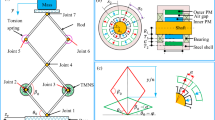Summary
Part I. Investigations with sinusoidal and stochastic octave-band-wide az-vibration with the frequencies or mid-band frequencies 2, 4, and 8 Hz, respectively, and the same r.m.s. of the vibration acceleration for both modes of vibration and a 30-minute exposure are reported. In order to assess the effect, measurements of the transmission, vibration-related changes of the electromyogram of the dorsal muscles, the regulation of the body-posture (stabilography), the vestibular galvanic excitability, and psychically regulated performances were used.
With a controlled unrestrained body-posture the transmission is lower at the intensities 11 (2 Hz − 2.4 m/s2; 4 Hz − 1.7 m/s2; 8 Hz − 1.7 m/s2) than at the intensities 12 (2 Hz − 1.2 m/s2; 4 Hz − 0.85 m/s2; 8 Hz − 0.85 m/s2). With the resonance frequency 4 Hz this non-linearity is particularly marked. A systematic difference between sinusoidal and stochastic vibration is not observed with regard to the transmission. Only stochastic vibration of 4 Hz − 0.85 m/s2 is more strongly damped than sinusoidal vibration of the same r.m.s.
Summary
Part II. On exposure to vibration the electrical muscular activity of the dorsal extensor increases (ECG-potentials eliminated) when the body-posture is strictly controlled. The higher vibration intensity 11 leads to a greater increase of the activity than the lower 12. The intensity dependence is particularly marked in the range 4 Hz. On exposure at 2 Hz the increase of the muscular activity is smaller than at 4 Hz or 8 Hz. No difference in the muscular response to sinusoidal and stochastic vibration can be shown by means of the mean muscular voltage. The muscular response under exposure to vibration is regarded as a reflex reaction which can produce an active vibration damping with exposure-dependent effectivity.
The regulation of the body posture, characterized by the standard deviation (s) of the amplitude-histogram of stabilograms, shows a dependence on the vibration frequency immediately after exposure. After exposure to 2 Hz vibration there is (in contrast to 4 Hz and 8 Hz) a marked increase of s in the sagittal stabilogram, which is interpreted as a symptom of a latent kinetosis. Under the conditions studied it can be said that sinusoidal and stochastic vibrations do not affect the standard deviation differently. The galvanic vestibular excitability is recorded quantitatively as mean body-sway response (b.s.r.). After stochastic vibration the b.s.r. is less marked than after sinusoidal vibration. 15 minutes after the end of the stochastic vibration with the intensity I1 the b.s.r. is still smaller than after exposure to sinusoidal vibration of the same intensity. These results are discussed in relation to a different effect on the otolithes, which is dependent on the mode of vibration.
Summary
Part III. Psychically regulated performances are investigated by means of the optical clock-test and an acoustical signal-detection during az-vibrations (2 Hz − 2.4 and 1.2 m/s2; 4 Hz − 1.7 and 2.4 m/s2; 8 Hz − 1.7 and 3.4 m/s2). Already when the “fatigue-decreased proficiency boundary” of ISO 2631 is not exceeded, significant performance-worsenings cannot be excluded. When this intensity is exceeded, marked performance-worsenings are observed. The results indicate that the frequencies 2 Hz and 4 Hz produce a stronger performance-worsening than a vibration of 8 Hz; statistically ensured differences can, however, not be shown. Sinusoidal and stochastic vibrations of the same r.m.s. do not differ with respect to their effects on psychically regulated performance; their subjective assessment is, however, different. From the results described in parts I, II, and III we conclude that:
-
1.
the investigated sinusoidal and stochastic vibrations have nearly the same biological effects; there are some indications of more marked effects of stochastic vibration;
-
2.
the “fatigue-decreased proficiency boundary” of ISO 2631 for the physical conditions investigated is minimum requirement for guaranteeing the entire proficiency;
-
2.
for the frequency 2 Hz a stronger biological effect can be assumed than that fixed at present in ISO 2631.
The hypothesis is discussed that a more pronounced effect of stochastic vibration, compared with sinusoidal vibration, can occur with increasing intensity and/or exposure time.
Similar content being viewed by others
Author information
Authors and Affiliations
Additional information
The physical investigations were carried out by R. Rothe in collaboration with E. Denisov. The authors are indebted to G. Weber for assistance and collaboration.
Rights and permissions
About this article
Cite this article
Bastek, R., Buchholz, C., Denisov, E.I. et al. Comparison of the effects of sinusoidal and stochastic octave-band-wide vibrations — a multi-disciplinary study. Int. Arch Occup Environ Heath 39, 143–152 (1977). https://doi.org/10.1007/BF00405659
Issue Date:
DOI: https://doi.org/10.1007/BF00405659




